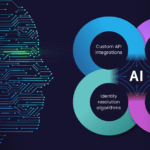
How do you calculate ROI for AI projects: Real-world examples in financial services, retail and contact centers
The current business environment demands one essential question regarding AI investment decisions: Does the investment make sense? The business community requires concrete data to support AI investment decisions because executives and decision-makers need more than buzzwords to authorize multi-million-dollar investments. Decision-makers require precise financial gains supported by thorough research. Successful AI adoption depends on Return on Investment (ROI) calculation as its fundamental element. This detailed guide explains how to calculate ROI for AI projects through real-world examples from telecommunications and financial services and retail sectors. The following examples with realistic metrics show how these technologies generate significant financial results when organizations implement them correctly.
Understanding ROI in the AI context
ROI (Return on Investment) measures the financial performance of an investment relative to its cost:
Where net benefit = Total financial gains - Total investment cost
For example, if a large enterprise invests $10 million in an AI solution that generates $45 million in value, the ROI calculation would be:
This 350% ROI means the company gains $3.50 in net value for every $1 invested – a convincing financial justification.
However, AI ROI calculations come with unique complexities:
- Multi-year benefits
AI systems often deliver increasing returns over time as they learn and improve.
- Quantifying indirect benefits
Customer satisfaction improvements, brand enhancement, and employee retention.
- Accounting for risk
The probability of technical success and adoption rates.
- Separating hype from reality
Setting realistic expectations for implementation timelines and results.
The 5-step framework for calculating AI ROI
To navigate these complexities, here's a structured approach to calculating AI ROI:
Step 1: Establish your baseline with measurable metrics
Document your current performance using specific, quantifiable metrics:
- Financial metrics: Revenue, costs, margins, inventory value
- Operational metrics: Processing times, error rates, cycle times
- Customer metrics: Satisfaction scores, churn rates, lifetime value
- Employee metrics: Productivity, turnover, training costs
Pro tip: Gather 12-36 months of historical data to account for seasonality and trends.
Step 2: Define your AI solution with specific capabilities
Clearly articulate what your AI solution will deliver:
- What specific business processes will it transform?
- Which tasks will be automated, augmented, or accelerated?
- What new capabilities will be enabled?
- How will it integrate with existing systems and workflows?
Pro tip: Identify the specific AI approaches being used (machine learning, computer vision, NLP) and how they align with your business objectives.
Step 3: Quantify the benefits through multiple lenses
Translate AI capabilities into financial value across categories:
- Direct cost reduction: Labor savings, error reduction, waste elimination
- Revenue enhancement: Higher conversion rates, larger basket sizes, new revenue streams
- Asset optimization: Inventory reduction, equipment utilization, space efficiency
- Risk mitigation: Fraud prevention, compliance improvement, reduced liability
- Time value: Faster processes, reduced time-to-market, quicker insights
Pro tip: For each benefit category, use sensitivity analysis with conservative, expected, and optimistic scenarios.
Step 4: Calculate the total cost with full transparency
Include all cost categories in your analysis:
- Technology costs: Software licenses, cloud services, hardware
- Implementation costs: Integration services, customization, data preparation
- Organizational costs: Training, change management, new roles
- Operational costs: Ongoing maintenance, updates, monitoring, support
Pro tip: Build in a 15-20% contingency for unexpected costs, particularly for first-time AI implementations.
Step 5: Perform the ROI calculation with time considerations
Calculate ROI across multiple timeframes:
- First-year ROI (typically lower due to implementation costs)
- Multi-year ROI (3-5 years to show full potential)
- Steady-state annual ROI (ongoing annual returns)
Pro tip: Use Net Present Value (NPV) calculations for multi-year assessments to account for the time value of money.
Real-world Examples
Financial Services: AI-powered fraud detection
The baseline (before AI)
Let's examine a large multinational bank with assets of $750 billion that processes over 3 billion transactions annually:
Current fraud management metrics:
- Annual fraud losses: $38 million (undetected fraud that results in direct loss)
- False positives: 75% of alerts (wasting analyst time and frustrating customers)
- Fraud operations team: 175 full-time employees
- Average fully loaded cost per analyst: $95,000/year
- Fraud management operational costs: $16.6 million annually
- Additional overhead (management, systems, facilities): $7.4 million
- Total annual fraud-related costs: $62 million
The AI solution
The bank implements an enterprise-grade AI-driven fraud detection system that:
- Analyzes transactions in real-time using 1,000+ behavioral variables
- Adapts to new fraud patterns without manual reprogramming
- Ranks alerts by risk score to prioritize investigation
- Provides explainable results to support regulatory compliance
Quantifiable benefits (with detailed calculations)
1. Reduced fraud losses:
- Current annual fraud losses: $38 million
- AI detection improvement: 65% reduction in undetected fraud
- New annual fraud losses: $38M × (1 - 0.65) = $13.3M
- Annual fraud loss savings: $38M - $13.3M = $24.7 million
2. Operational efficiency:
- Current false positive rate: 75%
- New false positive rate with AI: 40% (46.7% reduction)
- Current operational costs: $16.6M
- Labor efficiency gain: 35% reduction in investigation time
- New operational costs: $16.6M × (1 - 0.35) = $10.8M
- Annual operational savings: $16.6M - $10.8M = $5.8 million
3. Reduced overhead:
- Current overhead: $7.4M
- Reduction in supporting systems and management: 15%
- New overhead: $7.4M × (1 - 0.15) = $6.3M
- Annual overhead savings: $7.4M - $6.3M = $1.1 million
4. Regulatory fine avoidance:
- Average regulatory fine for inadequate fraud controls: $5M per occurrence
- Probability of receiving fine (historically): 20% annually
- Expected annual cost: $5M × 0.2 = $1M
- New probability with enhanced AI controls: 5%
- New expected annual cost: $5M × 0.05 = $0.25M
- Annual compliance risk savings: $1M - $0.25M = $0.75 million
Total annual benefit calculation:
- Fraud loss reduction: $24.7M
- Operational efficiency: $5.8M
- Overhead reduction: $1.1M
- Compliance risk reduction: $0.75M
- Total annual benefit: $32.35 million
Cost of the AI solution
Initial implementation (Year 1):
- Enterprise software license: $5.5 million
- Hardware and infrastructure: $1.2 million
- System integration: $2.8 million
- Data preparation and model training: $1.5 million
- Staff training: $0.5 million
- Total implementation cost: $11.5 million
Annual ongoing costs:
- Software maintenance/updates: $1.1 million (20% of license)
- Infrastructure maintenance: $0.4 million
- AI specialist team (6 FTEs): $1.2 million
- Periodic model retraining: $0.8 million
- Total annual ongoing cost: $3.5 million
ROI Calculation
5-year ROI analysis:
- Initial investment: $11.5M
- Annual ongoing cost: $3.5M
- Total 5-year cost: $11.5M + (4 × $3.5M) = $25.5M
- Annual benefit: $32.35M
- Total 5-year benefit: 5 × $32.35M = $161.75M
- Net 5-year gain: $161.75M - $25.5M = $136.25M
- 5-year ROI: ($136.25M / $25.5M) × 100% = 534%
First-year ROI:
- First-year cost: $11.5M (implementation) + $3.5M (ongoing) = $15M
- First-year benefit: $32.35M
- Net first-year gain: $32.35M - $15M = $17.35M
- First-year ROI: ($17.35M / $15M) × 100% = 116%
Annual ROI after year 1:
- Annual cost: $3.5M
- Annual benefit: $32.35M
- Annual net gain: $32.35M - $3.5M = $28.85M
- Annual ROI: ($28.85M / $3.5M) × 100% = 824%
Beyond the numbers
The AI fraud detection system delivers substantial qualitative benefits:
- Enhanced customer experience with 70% fewer false declines
- Improved analyst job satisfaction (addressing complex cases vs. routine alerts)
- Greater adaptability to emerging fraud schemes
- Superior reporting capabilities for management and regulators
With a first-year ROI of 116% and a sustained annual ROI of 824% thereafter, this AI investment not only pays for itself quickly but continues delivering exceptional financial returns while strengthening the bank's security posture and customer relationships.
Retail: AI-driven demand forecasting
The baseline (before AI)
Let's analyze a large national retail chain with 1,200 stores and $12 billion in annual revenue:
Current inventory management metrics:
- Annual revenue: $12 billion
- Product categories: 85
- SKUs managed: 120,000+
- Inventory turns per year: 6.2 (industry average: 8.5)
- Inventory value at any time: $1.6 billion
- Lost sales due to stockouts: $480 million annually (4% of potential revenue)
- Markdown costs from overstock: $360 million annually (3% of revenue)
- Obsolescence/spoilage: $120 million annually (1% of revenue)
- Planning staff: 85 FTEs at average cost of $92,000 each = $7.82 million
- Total annual cost of forecasting inaccuracies: $967.82 million
The AI solution
The retailer implements an enterprise-grade AI demand forecasting and inventory optimization system that:
- Integrates 5+ years of historical sales data across all channels
- Incorporates 200+ external variables (weather, events, social media sentiment, etc.)
- Forecasts at the SKU/store/day level with rolling 16-week projections
- Automates replenishment recommendations with dynamic safety stock calculations
- Offers what-if scenario modeling for promotions and new product launches
Quantifiable benefits (with detailed calculations)
1. Reduced stockouts:
- Current annual lost sales: $480 million
- Stockout reduction rate with AI: 65%
- New annual lost sales: $480M × (1 - 0.65) = $168M
- Recovered sales: $480M - $168M = $312M
- Average profit margin: 32%
- Additional profit from recovered sales: $312M × 0.32 = $99.84 million
2. Reduced markdowns:
- Current annual markdown costs: $360 million
- Markdown reduction rate with AI: 45%
- New annual markdown costs: $360M × (1 - 0.45) = $198M
- Annual markdown savings: $360M - $198M = $162 million
3. Reduced obsolescence/spoilage:
- Current annual obsolescence/spoilage: $120 million
- Reduction rate with AI: 40%
- New annual obsolescence/spoilage: $120M × (1 - 0.4) = $72M
- Annual obsolescence savings: $120M - $72M = $48 million
4. Inventory optimization:
- Current average inventory: $1.6 billion
- Inventory reduction target: 12%
- New average inventory: $1.6B × (1 - 0.12) = $1.408B
- Inventory reduction: $1.6B - $1.408B = $192M
- Cost of capital: 8%
- Annual carrying cost savings: $192M × 0.08 = $15.36 million
5. Labor efficiency:
- Current planning staff cost: $7.82 million
- Efficiency improvement: 30%
- New planning staff cost: $7.82M × (1 - 0.3) = $5.47M
- Annual labor savings: $7.82M - $5.47M = $2.35 million
Total annual benefit calculation:
- Additional profit from recovered sales: $99.84M
- Markdown savings: $162M
- Obsolescence savings: $48M
- Carrying cost savings: $15.36M
- Labor savings: $2.35M
- Total annual benefit: $327.55 million
Cost of the AI solution
Initial implementation (year 1):
- Enterprise software license: $12 million
- Infrastructure upgrades: $5.5 million
- Data integration: $8.2 million
- Implementation consulting: $3.6 million
- Change management and training: $2.1 million
- Total implementation cost: $31.4 million
Annual ongoing costs:
- Software maintenance/updates: $2.4 million (20% of license)
- Cloud computing resources: $1.8 million
- Data science and AI specialist team: $3.2 million
- Ongoing training and support: $0.8 million
- Total annual ongoing cost: $8.2 million
ROI calculation
3-year ROI analysis:
- Initial investment: $31.4M
- Annual ongoing cost: $8.2M
- Total 3-year cost: $31.4M + (2 × $8.2M) = $47.8M
- Annual benefit: $327.55M
- Total 3-year benefit: 3 × $327.55M = $982.65M
- Net 3-year gain: $982.65M - $47.8M = $934.85M
- 3-year ROI: ($934.85M / $47.8M) × 100% = 1,956%
First-year ROI:
- First-year cost: $31.4M (implementation) + $8.2M (ongoing) = $39.6M
- First-year benefit (assuming 70% of full potential): $327.55M × 0.7 = $229.29M
- Net first-year gain: $229.29M - $39.6M = $189.69M
- First-year ROI: ($189.69M / $39.6M) × 100% = 479%
Annual ROI after year 1:
- Annual cost: $8.2M
- Annual benefit (full realization): $327.55M
- Annual net gain: $327.55M - $8.2M = $319.35M
- Annual ROI: ($319.35M / $8.2M) × 100% = 3,895%
Beyond the numbers
The AI forecasting system delivers substantial qualitative benefits:
- Improved inventory turns from 6.2 to 8.7 (exceeding industry average)
- 28% reduction in time-to-react to demand shifts
- Enhanced customer satisfaction with 65% fewer stockouts
- More effective promotional planning with 22% higher conversion
- Reduced environmental impact from less waste
- Strategic resource reallocation from routine planning to value-added customer initiatives
With a first-year ROI of 479% and a stunning annual ROI of 3,895% thereafter, this AI investment transforms the retailer's entire inventory management approach while generating nearly $1 billion in value over just three years.
Telecom: AI-enhanced customer support
The baseline (before AI)
Let's examine a mid-sized telecom company with 12 million subscribers and $8.4 billion in annual revenue:
Current contact center metrics:
- Contact centers: 5 locations globally
- Total agents: 4,800
- Annual call volume: 42 million calls
- Chats/emails/social media: 18 million interactions
- Average handle time (AHT): 8.2 minutes per call
- Average wait time: 3.8 minutes
- First call resolution (FCR) rate: 68%
- Customer satisfaction score: 72/100
- Agent attrition rate: 35% annually
- Fully-loaded agent cost: $34/hour ($70,720/year)
- Total annual contact center cost: $422 million
Further breakdown of costs:
- Agent labor: $339.46 million (80.4%)
- Supervisor/management: $40.09 million (9.5%)
- Technology/telephony: $29.54 million (7%)
- Facilities: $12.66 million (3%)
- Training: $4.22 million (1%)
The AI solution
The telecom implements a comprehensive AI customer experience platform:
- Conversational AI (voice and chat) for self-service interactions
- Agent assisted AI with real-time recommendations and automation
- Sentiment analysis for escalation prediction
- Automated post-contact summarization and categorization
- Customer journey analytics for systemic issue identification
Quantifiable benefits (with detailed calculations)
1. Call deflection (automation):
- Current annual call volume: 42 million
- Percentage of calls suitable for automation: 38%
- Automation success rate: 75%
- Calls fully handled by AI: 42M × 0.38 × 0.75 = 11.97M calls
- Average handle time: 8.2 minutes
- Total hours saved: 11.97M × (8.2/60) = 1.64M hours
- Cost per hour: $34
- Annual savings from full automation: 1.64M × $34 = $55.76 million
2. Partial automation and reduced handle time:
- Remaining agent-handled calls: 42M - 11.97M = 30.03M calls
- Handle time reduction with AI assist: 25%
- New average handle time: 8.2 × (1 - 0.25) = 6.15 minutes
- Time saved per call: 8.2 - 6.15 = 2.05 minutes
- Total hours saved: 30.03M × (2.05/60) = 1.03M hours
- Annual savings from handle time reduction: 1.03M × $34 = $35.02 million
3. Improved first call resolution:
- Current FCR: 68%
- New FCR with AI: 85% (25% improvement)
- Current repeat calls: 42M × (1 - 0.68) = 13.44M calls
- New repeat calls: 30.03M × (1 - 0.85) = 4.5M calls
- Reduction in repeat calls: 13.44M - 4.5M = 8.94M calls
- Hours saved: 8.94M × (8.2/60) = 1.22M hours
- Annual savings from improved FCR: 1.22M × $34 = $41.48 million
4. Reduced training time:
- New agent training time: reduced by 30%
- Current training cost: $4.22M
- Annual training savings: $4.22M × 0.3 = $1.27 million
5. Reduced attrition:
- Current attrition rate: 35%
- New attrition rate with improved agent experience: 25%
- Current replacement cost: 1,680 agents (35% of 4,800) × $8,500 cost per hire = $14.28M
- New replacement cost: 1,200 agents (25% of 4,800) × $8,500 = $10.2M
- Annual attrition-related savings: $14.28M - $10.2M = $4.08 million
6. Revenue impact from improved CSAT:
- Current CSAT: 72/100
- New CSAT with AI: 86/100
- Churn reduction from CSAT improvement: 0.8 percentage points
- Current annual churn: 18% (2.16M subscribers)
- New annual churn: 17.2% (2.064M subscribers)
- Subscribers retained: 96,000
- Average annual revenue per user: $700
- Annual revenue preserved: 96,000 × $700 = $67.2 million
- Profit margin: 35%
- Annual profit impact: $67.2M × 0.35 = $23.52 million
Total annual benefit calculation:
- Savings from full automation: $55.76M
- Savings from handle time reduction: $35.02M
- Savings from improved FCR: $41.48M
- Training savings: $1.27M
- Attrition-related savings: $4.08M
- Profit from reduced churn: $23.52M
- Total annual benefit: $161.13 million
Cost of the AI solution
Initial implementation (Year 1):
- Conversational AI platform: $16.5 million
- Agent assisted solution: $8.2 million
- Analytics platform: $5.4 million
- Integration services: $10.8 million
- Change management and training: $4.2 million
- Total implementation cost: $45.1 million
Annual ongoing costs:
- Software licenses and maintenance: $7.6 million
- Cloud infrastructure: $4.2 million
- AI/ML operations team: $3.8 million
- Content updates and optimization: $2.4 million
- Total annual ongoing cost: $18 million
ROI calculation
5-year ROI analysis:
- Initial investment: $45.1M
- Annual ongoing cost: $18M
- Total 5-year cost: $45.1M + (4 × $18M) = $117.1M
- Annual benefit: $161.13M
- Total 5-year benefit: 5 × $161.13M = $805.65M
- Net 5-year gain: $805.65M - $117.1M = $688.55M
- 5-year ROI: ($688.55M / $117.1M) × 100% = 588%
First-year ROI:
- First-year cost: $45.1M (implementation) + $18M (ongoing) = $63.1M
- First-year benefit (assuming 60% of full potential): $161.13M × 0.6 = $96.68M
- Net first-year gain: $96.68M - $63.1M = $33.58M
- First-year ROI: ($33.58M / $63.1M) × 100% = 53%
Annual ROI after year 1:
- Annual cost: $18M
- Annual benefit (full realization): $161.13M
- Annual net gain: $161.13M - $18M = $143.13M
- Annual ROI: ($143.13M / $18M) × 100% = 795%
Beyond the numbers
The AI contact center solution delivers substantial qualitative benefits:
- Average wait time reduced from 3.8 minutes to 45 seconds
- 24/7 consistent customer service across all channels
- 42% increase in digital channel adoption
- 95% accuracy in intent recognition
- Improved compliance with automatic call recording analysis
- Valuable customer insights for product development
- Enhanced agent engagement scores (from 68% to 82%)
With a first-year ROI of 53% and sustained annual ROI of 795% thereafter, this AI investment transforms the customer service experience while delivering nearly $700 million in value over five years. Even more importantly, it creates a competitive advantage through superior customer experience in an industry where satisfaction scores traditionally lag behind other sectors.
Making your AI investment decision
When evaluating AI projects, consider these key questions:
- Strategic alignment: Does this AI solution address a critical business need?
- Risk assessment: What's the likelihood of technical or implementation failure?
- Scalability: Can the solution grow with your business?
- Time horizon: How quickly will you see returns? Can you afford to wait?
Start small, think big
For organizations new to AI, consider starting with a pilot project:
- Define a narrow, high-impact use case
- Establish clear metrics upfront
- Set realistic timelines
- Document everything for future scaling
By demonstrating a positive ROI on a smaller scale, you'll build confidence and momentum for broader AI initiatives.
Conclusion: Beyond the numbers
While ROI provides a crucial framework for evaluating AI investments, remember that some of the most transformative benefits may not fit neatly into a formula. The ability to innovate faster, make better decisions, and create exceptional customer experiences can deliver value far beyond what shows up in your initial calculations.
The most successful organizations view AI not just as a cost-saving tool but as a strategic capability that can fundamentally change how they operate and compete. By starting with a disciplined ROI approach, you create the financial foundation that allows these broader transformations to take place.
Whether you're in financial services, retail, telecommunications, or any other industry, the process remains the same: establish your baseline, define your solution, quantify the benefits, calculate the costs, and determine your ROI. With this framework in hand, you'll be well-equipped to make AI investments that truly pay off.
Operational metrics for AI systems: measuring time and cost efficiency
Prompt Workflows:
- Token usage: Tracks the total tokens consumed per query to optimize costs.
- LLM API calls: Measures the number of times an LLM is called to complete a task, reducing unnecessary API usage.
- Tool invocation time: Evaluates the time taken when AI calls external tools or APIs, ensuring minimal delays in workflow execution.
Retrieval-Augmented Generation (RAG) Systems:
- Retrieval API call latency: Measures the time taken to fetch relevant context from vector databases or knowledge bases.
- Query processing time: Tracks computational time spent on generating vector embeddings and retrieving relevant documents.
- Compute overhead: Assesses additional processing time for reranking and filtering retrieved results, impacting response speed.
AI Agents:
- Tool invocation time: Evaluates delays in executing API calls when AI interacts with external tools.
- Average LLM calls to complete Task: Tracks how many LLM queries are needed before producing a final output, identifying inefficiencies.
- Total execution time: Measures end-to-end processing time, ensuring workflow automation remains cost-effective and scalable.
Fine-Tuning & Model Training:
- Fine-tuning time: Tracks the total time required for model fine-tuning, including gradient updates and convergence speed.
- Data curation effort: Measures the time and resources needed to clean, label, and preprocess training data for fine-tuning.
- Compute resources needed: Evaluates GPU/TPU usage and overall computational costs, ensuring resource efficiency during training.
- Checkpoint and iteration overhead: Measures the time spent on saving intermediate fine-tuning checkpoints and running multiple training iterations.
By monitoring these operational metrics, AI systems can be optimized for efficiency, scalability, and cost-effectiveness, ensuring smooth deployment of prompt-based models, RAG systems, AI agents, and fine-tuned models while reducing unnecessary computation. 🚀
Search
Trending Posts
GPT-5: The Reality Behind the Hype
- August 19, 2025
- 11 min read
Trump’s Saudi Tour: Oil Barrels to AI
- June 6, 2025
- 12 min read
Marketing’s Gen AI Leap
- May 20, 2025
- 18 min read
Gen AI: From Customer Support to Delight
- May 18, 2025
- 16 min read
AI-First Companies: From Buzzword to Real Change
- May 10, 2025
- 12 min read








